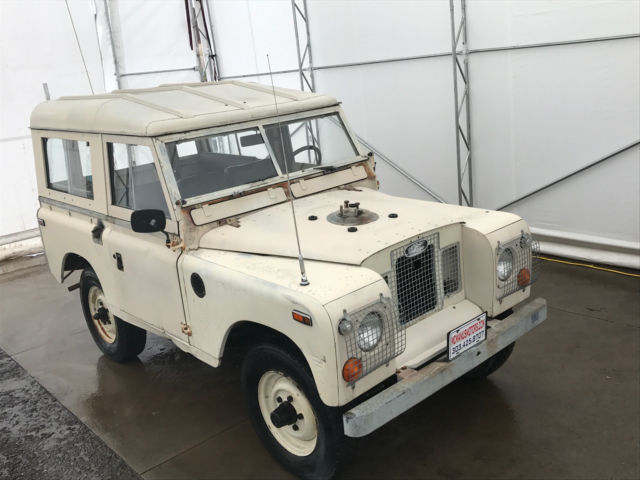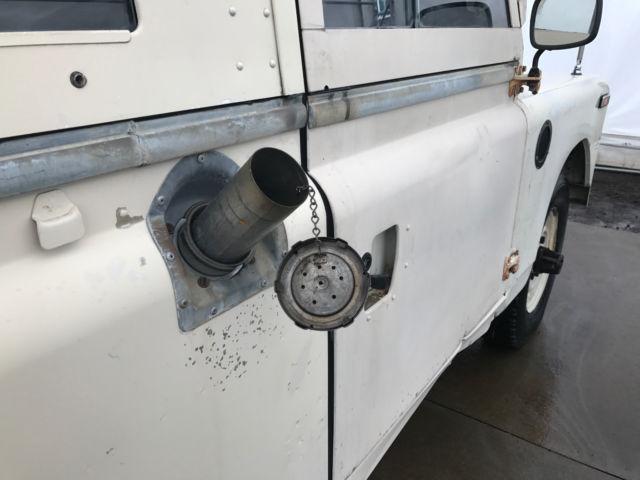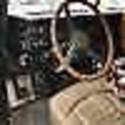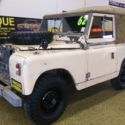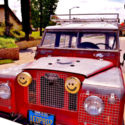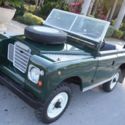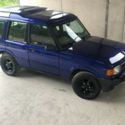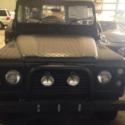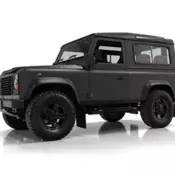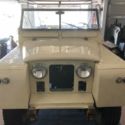1971 LAND ROVER SERIES II DISCOVERY DRIVING RUNNING DRIVES TRADES ACCEPTED
| Make: | Land Rover |
| Model: | Series II |
| SubModel: | -- |
| Type: | SUV |
| Trim: | -- |
| Year: | 1971 |
| Mileage: | 54,133 |
| VIN: | 24445115H |
| Color: | Tan |
| Engine: | 4-cylinders OHV |
| Cylinders: | 4 |
| Fuel: | Gasoline |
| Transmission: | Manual |
| Drive type: | 4WD |
| Interior color: | Black |
| Vehicle Title: | Clear |
| Item location: | Wheat Ridge, Colorado, United States |
1971 Land Rover Series II -- Additional Info:
Thank you for looking at this amazing 1971 Land Rover Series 1 4cyl 4sp legendary 4x4 action very cool very authentic. RUNNING DRIVING CONDITION, 4X4, LOW RANGE, BRAKES, CLUTCH AND FUEL PUMP IN WORKING OPERATIONAL ORDER ALL PLUGS FIRING GOOD COMPRESSION GOOD MANIFOLD (LOW PRESSURE) THE CARBURATION SYSTEM IS IN VERY GOOD SHAPE WITH AN IMMACULATE THROAT. STARTS EVERY TIME VERY CLEAN DRIVER STOPS WELL LIKE IT SHOULD CLEANED UP GREAT ALL LIGHTS AND BLINKERS WORK GREAT GLASS CLEAN TITLE GOOD TIRES NO REAL BAD LEAKS ALL FLUIDS TOPPED OFF AND FILLED TO SPEC. GREAT RUNNING TRUCK TIRES ARE A BIT DRY ROTTED WELL KEPT ORIGINAL COLORADO CAR WITH A FEW INDICATIONS OF PRIDE IN OWNERSHIP. BUY WITH CONFIDENCE THIS IS A RUNNING DRIVING TRUCK ALL ORIGINAL. WE HAVE THE RIM AND TIRE FOR THE HOOD. (I DONT PREFER DRIVING WITH THIS ON DUE TO THE LACK OF SIGHT) ALL TRADES WILL BE CONSIDERED. I LOOK FORWARD TO SEEING YOUR BIDS.
| This article needs additional citations for verification. Please help improve this article by adding citations to reliable sources. Unsourced material may be challenged and removed. (July 2012) (Learn how and when to remove this template message) |
| Land Rover Series I |
| Rover Company (1948-1967) British Leyland (1968-1983) |
| 1948–1985 |
| Solihull, England |
| Off-road vehicle |
| FR layout/All-wheel drive |
| Land Rover Ninety & One Ten |
The Land Rover Series I, II, and III (commonly referred to as series Land Rovers, to distinguish them from later models) are off-road vehicles produced by the British manufacturer Rover Company that were inspired by the US-built Willys Jeep. In 1992, Land Rover claimed that 70% of all the vehicles they had built were still in use.
Series models feature leaf-sprung suspension with selectable two or four-wheel drive (4WD); though the Stage 1 V8 version of the Series III featured permanent 4WD. All three models could be started with a front hand crank and had the option of a rear power takeoff for accessories.
Contents- 1 Development
- 2 Series I
- 3 Series II
- 4 Series IIA
- 5 Series IIA Forward Control
- 6 Series IIB Forward Control
- 7 Series III
- 8 Stage One V8
- 9 1 Ton 109 inch
- 10 Australia
- 11 South Africa
- 12 Military
- 12.1 Britain
- 12.2 Australia
- 12.3 New Zealand
- 13 Minerva
- 14 See also
- 15 References
- 16 External links
The Land Rover was conceived by the Rover Company in 1947 during the aftermath of World War II. Before the war Rover had produced luxury cars which were not in demand in the immediate post-war period and raw materials were strictly rationed to those companies building construction or industrial equipment, or products that could be widely exported to earn crucial foreign exchange for the country. Also, Rover's original factory in Coventry had been bombed during the war, forcing the company to move into a huge "shadow factory" built just before the war in Solihull near Birmingham, and used to construct Bristol Hercules aircraft engines. This factory was now empty but starting car production there from scratch would not be financially viable. Plans for a small, economical car known as the M Type were drawn up, and a few prototypes made, but would be too expensive to produce.
Maurice Wilks, Rover's chief designer came up with a plan to produce a light agricultural and utility vehicle, of a similar concept to the Willys Jeep used in the war, but with an emphasis on agricultural use. He was possibly inspired by the Standard Motor Company, who faced similar problems and were producing the highly successful Ferguson TE20 tractor in their shadow factory in Coventry. More likely, he used his own experience of using an army-surplus Jeep on his farm in Anglesey, North Wales. His design added a power take-off (PTO) feature since there was a gap in the market between jeeps and tractors (which offered the feature but were less flexible as transport). The original Land Rover concept (a cross between a light truck and a tractor) is similar to the Unimog, which was developed in Germany during this period.
The first prototype had a distinctive feature — the steering wheel was mounted in the middle of the vehicle. It hence became known as the "centre steer". It was built on a Jeep chassis and used the engine and gearbox out of a Rover P3 saloon car. The bodywork was handmade out of an aluminium/magnesium alloy called Birmabright, to save on steel, which was closely rationed. The choice of colour was dictated by military surplus supplies of aircraft cockpit paint, so early vehicles only came in various shades of light green. The first pre-production Land Rovers were being developed in late 1947 by a team led by engineer Arthur Goddard.[1]
Tests showed this prototype vehicle to be a capable and versatile machine. The PTO drives from the front of the engine and from the gearbox to the centre and rear of the vehicle allowed it to drive farm machinery, exactly as a tractor would. It was also tested ploughing and performing other agricultural tasks. However, as the vehicle was readied for production, this emphasis on tractor-like usage decreased and the centre steering proved impractical in use. The steering wheel was mounted off to the side as normal, the bodywork was simplified to reduce production time and costs and a larger engine was fitted, together with a specially designed transfer gearbox to replace the Jeep unit. The result was a vehicle that didn't use a single Jeep component and was slightly shorter than its American inspiration, but wider, heavier, faster and still retained the PTO drives.
The Land Rover was designed to only be in production for two or three years to gain some cash flow and export orders for the Rover Company so it could restart up-market car production. Once car production restarted, however, it was greatly outsold by the off-road Land Rover, which developed into its own brand that remains successful today. Many of the defining and successful features of the Land Rover design were in fact the result of Rover's drive to simplify the tooling required for the vehicle and to use the minimum amount of rationed materials. As well as the aluminium alloy bodywork (which has been retained throughout production despite it now being more expensive than a conventional steel body due to its ideal properties of light weight and corrosion resistance) other examples include the distinctive flat body panels with only simple, constant-radius curves (originally used because they could be cut and formed by hand from aluminium sheet on a basic jig) and the sturdy box-section ladder chassis, which on Series vehicles was made up from four strips of steel welded at each side to form a box, thus cutting down on the complex welding operations required when making a more conventional U- or I-section frame.
Series I Series I Overview Production Body and chassis Bodystyle Powertrain Engine Transmission Dimensions Wheelbase Length Width Height Chronology Successor| Series I 86 Hard Top. Showing double-skinned '"Safari Roof". |
| 1948–1958 |
| 2-door Off-road vehicle 4-door Off-road vehicle 2-door pickup |
| 1.6 L I4 (1948–1951) /2.0 L I4 (beginning 1950) 2.0 L diesel I4 (1957–58) |
| 4-speed manual |
| 1948–1953: 80.0in (2,032mm) 1954–1956: 86.0in (2,184mm) (SWB) 1948–1956: 107.0in (2,718mm) (LWB) 1957–1958: 88.0in (2,235mm) (SWB) 109.0in (2,769mm) (LWB) |
| 132.0in (3,353mm)/140.5in (3,569mm) (SWB) 173.5in (4,407mm) (LWB) |
| 61.0in (1,549mm) |
| 73.5in (1,867mm) |
| Land Rover Series II |
Land Rover entered production in 1948 with what was later termed the Series I. This was launched at the Amsterdam Motor Show. It was originally designed for farm and light industrial use, and had a steel box-section chassis, and an aluminum body.
Originally the Land Rover was a single model offering, which from 1948 until 1951 used an 80-inch (2,000mm) wheelbase and a 1.6-litre petrol engine producing around 50bhp (37kW; 51PS). The four-speed gearbox from the Rover P3 was used, with a new two-speed transfer box. This incorporated an unusual four-wheel-drive system, with a freewheel unit (as used on several Rover cars of the time). This disengaged the front axle from the manual transmission on the overrun, allowing a form of permanent 4WD. A ring-pull mechanism in the driver's footwell allowed the freewheel to be locked to provide more traditional 4WD. This was a basic vehicle: tops for the doors and a roof (canvas or metal) were optional extras. In 1950, the lights moved from a position behind the grille to protruding through the grille.
From the beginning it was realised that some buyers would want a Land Rover's abilities without the spartan interiors. In 1949, Land Rover launched a second body option called the "Station Wagon", fitted with a body built by Tickford, a coachbuilder known for their work with Rolls-Royce and Lagonda. The bodywork was wooden-framed and had seating for seven people. Tickford was well equipped in comparison with the standard Land Rover, having leather seats, a heater, a one-piece laminated windscreen, a tin-plate spare wheel cover, some interior trim and other options. The wooden construction made them expensive to build. The Tickford was taxed as a private car, which attracted high levels of Purchase Tax unlike the original Land Rover. As a result, fewer than 700 Tickfords were sold, and all but 50 were exported.
In 1952 and 1953, a larger 2.0-litre petrol engine was fitted. This engine has Siamese bores, meaning that there are no water passages for cooling between the cylinders. During 1950, the unusual semi-permanent 4WD system was replaced with a more conventional setup, with drive to the front axle being taken through a simple dog clutch. Around this time the Land Rover's legal status was also clarified. As mentioned above, the Land Rover was originally classed as a commercial vehicle, meaning it was free from purchase tax. However, this also meant it was limited to a speed of 30mph (48km/h) on British roads. After an appeal to the Law Lords after an owner was charged with exceeding this limit, the Land Rover was classified as a "multi-purpose vehicle" which was only to be classed as a commercial vehicle if used for commercial purposes.
The 1954 model year brought major changes. The 80-inch (2,000mm) wheelbase model was replaced by an 86-inch (2,200mm) wheelbase model, and a 107-inch (2,700mm) "Pick Up" version was introduced. The extra wheelbase was added behind the cab area to provide additional load space. In mid-1954 the "spread bore" petrol engine was introduced (from engines 5710xxxx), allowing better cooling between the cylinders. This had been introduced in the Rover car the year before.[2] The engine was modified again in 1955 (from engine 1706xxxxx), sometimes known as the 'later' spread bore.
1956 saw the introduction of the first five-door model, on the 107-inch chassis known as the "Station Wagon" with seating for up to ten people. The 86-inch model was a three-door, seven-seater. The new station wagons were very different from the previous Tickford model, being built with simple metal panels and bolt-together construction instead of the complex wooden structure of the older Station Wagon. They were intended to be used both as commercial vehicles as people-carriers for transporting workmen to remote locations, as well as by private users. Like the Tickford version, they came with basic interior trim and equipment such as roof vents and interior lights.
The Station Wagons saw the first expansion of the Land Rover range. Station Wagons were fitted with a "Safari Roof" which consisted of a second roof skin fitted on top of the vehicle. This kept the interior cool in hot weather and reduced condensation in cold weather. Vents fitted in the roof allowed added ventilation to the interior. While they were based on the same chassis and drivetrains as the standard vehicles, Station Wagons carried different chassis numbers, special badging, and were advertised in separate brochures. Unlike the original Station Wagon, the new in-house versions were highly popular.
In mid-1956 the wheelbases were extended by 2 inches (51mm) to 88 inches (2,200mm) and 109 inches (2,800mm), and the front chassis cross-member was moved an inch forward, to accommodate the new diesel engine, to be an option the following year. This change was made to all models with the exception of the 107 Station Wagon, which would never be fitted with a diesel engine, and would eventually be the last series I in production. These dimensions were to be used on all Land Rovers for the next 25 years.
In 1957 a brand new 2.0-litre diesel engine was introduced that, despite the similar capacity, was not related to the petrol engines used. The petrol engines of the time used the rather out-dated inlet-over-exhaust valve arrangement; the diesel used the more modern overhead valve layout. This diesel engine was one of the first high-speed diesels developed for road use, producing 52hp (39kW) at 4,000rpm.
-
1948 Land Rover 80in Tickford Estate
| 1958–1961 |
| 2-door Off-road vehicle 4-door Off-road vehicle 2-door pickup |
| 2.0 L petrol I4 2.25 L petrol I4 2.0 L I4 diesel |
| 4-speed manual |
| 88.0in (2,235mm) (SWB) 109.0in (2,769mm) (LWB) |
| 142.4in (3,617mm) (SWB) 175.0in (4,445mm) (LWB) |
| 66.0in (1,676mm) |
| 77.5in (1,968mm) (SWB) 81.0in (2,057mm) (LWB) |
| Land Rover Series I |
| Land Rover Series IIA |
The successor to the successful Series I was the Series II, which saw a production run from 1958 to 1961. It came in 88in (2,200mm) and 109in (2,800mm) wheelbases (normally referred to as the 'SWB' and 'LWB'). This was the first Land Rover to receive the attention of Rover's styling department- Chief Stylist David Bache produced the familiar 'barrel side' waistline to cover the vehicle's wider track and the improved design of the truck cab variant, introducing the curved side windows and rounded roof still used on current Land Rovers. The Series II was the first vehicle to use the well-known 2.25-litre petrol engine, although the first 1,500 or so short wheelbase (SWB) models retained the 52hp (39kW) 2.0-litre petrol engine from the Series I. This larger petrol engine produced 72hp (54kW) and was closely related to the 2.0-litre diesel unit still in use. This engine became the standard Land Rover unit until the mid-1980s when diesel engines became more popular.
The 109-inch (2,800mm) Series II Station Wagon introduced a twelve-seater option on top of the standard ten-seater layout. This was primarily to take advantage of UK tax laws, by which a vehicle with 12 seats or more was classed as a bus, and was exempt from Purchase Tax and Special Vehicle Tax. This made the twelve-seater not only cheaper to buy than the 10-seater version, but also cheaper than the seven-seater 88-inch (2,200mm) Station Wagon. The twelve-seater layout remained a highly popular body style for decades, being retained on the later Series and Defender variants until 2002, when it was dropped. The unusual status of the twelve-seater remained until the end—such vehicles were classed as minibuses and thus could use bus lanes and (if registered correctly) could be exempt from the London Congestion Charge.
There was some degree of over-lap between Series I and Series II production. Early Series II 88-inch (2,200mm) vehicles were fitted with the old 2-litre petrol engine to use up existing stock from production of the Series I 107-inch (2,700mm) Station Wagon continued until late 1959 due to continued demand from export markets and to allow the production of Series II components to reach full level.
-
1958 Land Rover Series II 88in, Royal Review Vehicle 'State II'
-
1958 Land Rover Series II Cuthbertson
| 1961–1971 |
| 2-door Off-road vehicle 4-door Off-road vehicle 2-door pickup |
| 2.25 L I4 Petrol 2.25 L I4 diesel 2.6 L IOE engine I6 |
| 4-speed manual |
| 88.0in (2,235mm) (SWB) 109.0in (2,769mm) (LWB) |
| 142.4in (3,617mm) (SWB) 175.0in (4,445mm) (LWB) |
| 66.0in (1,676mm) |
| 77.5in (1,968mm) (SWB) 81.0in (2,057mm) (LWB) |
| Land Rover Series II |
| Land Rover Series III |
The SII and the SIIA are very difficult to distinguish. There were some minor cosmetic changes, but the most significant change was under the bonnet in the guise of the new 2.25-litre diesel engine. Body configurations available from the factory ranged from short-wheelbase soft-top to the top-of-the-line five-door station wagon. In 1967 a 2.6-litre inline six cylinder petrol engine was introduced for the long-wheelbase models, which also had servo-assisted brakes. 811 of these were NADA (or North American Dollar Area) trucks, which were the only long-wheelbase models made for the American and Canadian markets.
From February 1969 (home market), the headlamps moved into the wings on all models, and the sill panels were redesigned to be shallower a few months afterwards.
The Series IIA is considered by many the most hardy Series model constructed. It is quite possibly also the type of classic Land Rover that features strongly in the general public's perception of the Land Rover, from its many appearances in popular films and television documentaries set in Africa throughout the 1960s, such as Born Free. In February 1968, just a few months after its manufacturer had been subsumed, under government pressure, into the Leyland Motor Corporation, the Land Rover celebrated its twentieth birthday, with total production to date just short of 600,000, of which more than 70% had been exported.[3] Certainly it was whilst the Series IIA was in production that sales of utility Land Rovers reached their peak, in 1969–70, when sales of over 60,000 Land Rovers a year were recorded. (For comparison, the sales of the Defender in recent years have been around the 25,000 level since the 1990s.) As well as record sales, the Land Rover dominated many world markets- in Australia in the 1960s Land Rover held 90% of the 4×4 market. This figure was repeated in many countries in Africa and the Middle East.
-
1963 Land Rover
Series IIA pickup-type -
A Series IIA without canvas
-
Land Rover Series IIa Station Wagon coil sprung hybrid
-
1961-1966 Forest Rover (on the left)
The Series IIA FC launched in 1962 was based on the Series IIA 2.25-litre petrol engine and 109in (2,769mm) chassis, with the cab positioned over the engine to give more load space. Export vehicles were the first Land-Rovers to get the 2.6-litre petrol engine. Most examples had an ENV (heavy duty) rear axle, a matching front axle came later. Tyres were large 900×16 types on deep-dish wheel rims to spread the ground weight of this heavy vehicle. These vehicles were somewhat underpowered for the increased load capacity (1.5 long tons or 1,500kg), and most had a hard working life. Less than 2,500 were made, and most had a utility body, but surviving examples often have custom bodywork. With an upgraded powertrain, they can be used as a small motorhome.
-
Land Rover Series IIA Forward Control Fire Engine
The Series IIB FC produced from 1966 was similar to the Series IIA Forward Control but added the 2.25-litre diesel engine as an option. The 2.25-litre engine was the standard engine for this model, the 2.6-litre engine being only available for export.
Heavy duty wide-track axles (designed by ENV) were fitted to improve vehicle stability, as was a front anti-roll bar and revised rear springs which were mounted above the axle rather than below it. In the process the wheelbase was increased to 110in (2,794mm). Production ended in 1974 when Land-Rover rationalised its vehicle range. Many IIB components were also used on the "1 Ton" 109in vehicle.
Series III Series III Overview Production Body and chassis Bodystyle Powertrain Engine Transmission Dimensions Wheelbase Length Width Height Chronology Predecessor Successor| 1971–1985 |
| 2-door Off-road vehicle 4-door Off-road vehicle 2-door pickup |
| 2.25 L 73hp (54kW) I4 (Petrol) 2.25 L 62hp (46kW) I4 (Diesel) 2.6 L 86hp (64kW) I6 (Petrol) 3.5 L 91hp (68kW) V8 (Petrol) |
| 4-speed manual main transmission 2-speed manual transfer gearbox Selectable 4-wheel drive |
| 88.0in (2,235mm) (SWB) 109.0in (2,769mm) (LWB) |
| 142.4in (3,617mm) (SWB) 175.0in (4,445mm) (LWB) |
| 66.0in (1,676mm) |
| 77.5in (1,968mm) (SWB) 81.0in (2,057mm) (LWB) |
| Land Rover Series IIA |
| Land Rover Ninety & One Ten |
The Series III had the same body and engine options as the preceding IIa, including station wagons and the 1 Ton versions. Little changed cosmetically from the IIA to the Series III. The Series III is the most common Series vehicle, with 440,000 of the type built from 1971 to 1985. The headlights were moved to the wings on late production IIA models from 1968/9 onward (ostensibly to comply with Australian, American and Dutch lighting regulations) and remained in this position for the Series III. The traditional metal grille, featured on the Series I, II and IIA, was replaced with a plastic one for the Series III model. The 2.25-litre engine had its compression raised from 7:1 to 8:1, increasing the power slightly (the high compression engine had been an optional fit on the IIa model for several years). During the Series III production run from 1971 until 1985, the 1,000,000th Land Rover rolled off the production line in 1976. The Series III saw many changes in the later part of its life as Land Rover updated the design to meet increased competition. This was the first model to feature synchromesh on all four gears, although some late H-suffix SIIA models (mainly the more expensive Station Wagons) had used the all-synchro box. In keeping with early 1970s trends in automotive interior design, both in safety and use of more advanced materials, the simple metal dashboard of earlier models was redesigned to accept a new moulded plastic dash. The instrument cluster, which was previously centrally located, was moved to the driver's side. Long-wheelbase Series III vehicles had the Salisbury rear axle (the differential housing and axle case are one piece)[clarification needed] as standard, although some late SIIA 109-inch (2,800mm) vehicles had them too.
In 1980, the 2.25-litre petrol and diesel engines received five main bearing crankshafts to increase rigidity and the transmission, axles and wheel hubs were strengthened. This was the culmination of a series of updates to the transmission that had been made since the 1960s to combat the all-too-common problem of the rear axle half-shafts breaking in heavy usage. This problem was partly due to the design of the shafts themselves. Due to the fully floating design of the rear wheel hubs, the half shafts can be removed very quickly without even having to jack the vehicle off the ground. The tendency for commercial operators to overload their vehicles exacerbated this flaw which blighted the Series Land Rovers in many of their export markets and established a reputation that continues in many markets to the present day. This is despite the 1982 re-design (mainly the increase of driving-splines from 10 to 24 to reduce stress) that all but solved the problem.
Also, new trim options were introduced to make the interior more comfortable if the buyer so wished (many farmers and commercial users preferred the original, non-trimmed interior).
These changes culminated in April 1982 with the introduction of the "County" spec. Station Wagon Land Rovers, available in both 88-inch (2,200mm) and 109-inch (2,800mm) types. These had all-new cloth seats from the Leyland T-45 Lorry, soundproofing kits, tinted glass and other "soft" options designed to appeal to the leisure owner/user.
Of more interest was the introduction of the High Capacity Pick Up to the 109-inch (2,800mm) chassis. This was a pick-up truck load bay that offered 25% more cubic capacity than the standard pick-up style. The HCPU came with heavy-duty suspension and was popular with public utility companies and building contractors.
Stage One V8From 1979 until 1985, the Stage 1 was built using some of the same components as the Range Rover and 101 Forward Control, such as the LT95 gearbox and 3.5-litre Rover V8 petrol engine. The engine was detuned to 91hp (68kW) from the 135BHP of the contemporary Range Rover.
The Stage 1 was normally available only in LWB 109-inch (2,800mm) form but 24 examples were built with the SWB 88in (2,235mm) wheelbase.[4]
"Stage 1" refers to the first stage of investment by the British Government in the company to improve the Land Rover and Range Rover product offerings, which eventually led to the Land Rover 90 and 110. The use of the Range Rover engine and drive train made it the only Series III vehicle to have permanent four-wheel drive.
1 Ton 109 inchThe 1 Ton 109inch was produced from 1968 to 1977, covering late IIA and series III Models. It was basically a Series IIB Forward Control built with a standard 109in body, featuring 2.6-litre petrol engine, lower ratio gearbox, ENV front and rear axles, (Salisbury front and rear on later Series IIIs) though some late IIAs were fitted with ENV axles in front and Salisbury on the rear. Later series IIIs had a Rover type front axle with uprated differential. The chassis frame was unique to the model and featured drop-shackle suspension similar to the military series Land Rovers. 900x16 tyres were a standard feature and these machines were commonly used by utility companies and breakdown/recovery firms. Only 170 IIA and 238 Series IIIs (1 Ton) were built for the home market. Export markets had even fewer examples, making this one of the rarest types of Land-Rover ever built.
AustraliaAustralia has always been an important export market for Land Rovers of various models, but especially the utility models. 80-inch Series I models were sold to the Australian government in the late 1940s for work on civil engineering projects such as dams and road construction, which brought the vehicle to the buying public's attention. Large sales followed and in the 1950s Land Rover established factories in Australia to build CKD kits shipped from the Solihull factory. The Land Rover continued to sell well throughout the 1960s in Series II guise, commanding some 90% of the off-road market, and with practically every farm having at least one Land Rover.
The Series III continued this success in the early 1970s, but from the middle of the decade sales declined. A large coal export deal to Japan relied on the subsequent import of Japanese cars and other goods, a combination of this increasing competition and increasingly poor quality of the components being shipped from Britain meant that Land Rover's dominance slipped. A problem specific to Australia was the always-limited supply of new Land Rovers. Leyland's factory never had the capacity to meet possible demand and the need to import almost the entire vehicle in kit form from Britain restricted the supply and manufacturing process further. This led to a long waiting list developing for the Leyland product whilst commercial operators could receive large fleets of Japanese vehicles very quickly. The other problems faced by Land Rover were the same throughout its export markets- compared to the Japanese competition, the Land Rover was underpowered, unreliable and slow with a poor ride quality, despite their superior off-road ability. Poor rust-proofing and low-quality steel used in comparison to the Japanese vehicles turned the buyers away in large numbers and by 1983, with the introduction of the One Ten, the Toyota Land Cruiser became the best-selling 4×4 in Australia.
In the early 1980s, Land Rover Australia had made some changes to the vehicle to try to combat this sales decline. As well as the fitting of the V8 petrol engine in the 1979 "Stage One", as in the rest of the world, Australia also received the same vehicle with the option of a 3.9-litre 97hp (72kW) four-cylinder Isuzu diesel engine (4BD1).[5] This was introduced in 1982, and was meant to be equipped in about ten percent of the Australian production. Top speed is 77mph (124km/h).[6] This helped slow the sales decline, but the rest of the vehicle's shortcomings let it down. The One Ten was also available with this engine, and a turbocharged version producing in excess of 100 horsepower (75kW) powered the military 6×6.
-
Land Rover Series III Pickup
-
Short wheelbase Land Rover Series III
South Africa's relationship with Land Rover started in 1949 when the first Series I 80-inch models were sold in South Africa. In August 1950, Car Distributors Assembly (Pty) Ltd assembled the first Land Rover CKD in Port Elizabeth, South Africa. The first local production of fuel tanks and chassis at the Port Elizabeth plant was announced in August 1963 and from then on the local content in the production of Land Rovers increased steadily to 44% of vehicle weight by 1972. Local content included: chassis, road springs, entire body, tyres, seat frames and upholstery, battery, fibreglass roof and all glass. In 1974 Leyland SA had 3 assembly plants. Local content increased further in 1980 with the Series IIIS models fitted with locally produced petrol(R6) and diesel(ADE 236) engines. In 1992 the Blackheath factory in the Cape Province was identified as the largest Land Rover CKD assembly outside the UK.[7]
MilitaryBritainThe British Army used Series Land Rovers in large numbers (and continues to use the modern Defender versions). The British Army tested the 80-inch (2,000mm) Series I Land Rover almost as soon as it was launched in 1948. At that time, the Army was more interested in developing a specially designed military utility 4×4 (the Austin Champ). However, the Champ proved too complex, heavy and unreliable in battlefield conditions so the Army looked to the Land Rover. In the late 1940s the Ministry of Defence was keen on the standardisation of its vehicles and equipment. Part of this plan was to fit Rolls-Royce petrol engines to all its vehicles (even though most were not actually built by R-R). A batch of Series I Land Rovers were fitted with Rolls-Royce B40 four-cylinder engine, which required modification to an 81-inch (2,100mm) wheelbase). However, the engine was too heavy and slow-revving, which stunted performance and produced torque that the Rover gearbox could only just cope with. Rover convinced the MOD that, considering the quantities of Land Rovers they were considering ordering, that the standard 1.6-litre engine would suffice. The MOD started ordering Land Rovers in batches from late 1949. The initial batches were for 50 vehicles, but by the mid-1950s the Army was buying Land Rovers 200 vehicles at a time.
Land Rovers were deployed to the Korean War and the Suez Crisis, and became standard light military vehicles throughout the Commonwealth.
However, as the 1960s progressed, more and more specialised versions were developed. As well as the standard 'GS' (General Service) vehicles, a common variant was the 'FFR' (Fitted For Radio', which had 24-volt electrics and a large engine-powered generator to power on-board radios. There were also Ambulances on the 109-inch (2,800mm) Series II and Series III chassis. A well-known version was the LRDPV (Long-Range Desert Patrol Vehicle), commonly called the 'Pink Panther', on account of their distinctive light pink sand camouflage. These 109-inch (2,800mm) Series IIs were stripped of doors and windscreens and fitted with grenade launchers, a machine gun mounting ring and long-range fuel tanks and water tanks. They were used by the SAS for desert patrol and special operations.
1983 Series III HT LightweightBy the late 1970s, the British Army had acquired around 9,000 Series III models, which were mainly a special 'Heavy Duty' version of the 109-inch (2,800mm) Soft Top. These models had improved suspension components and a different chassis cross-member design. These were produced in 12-volt 'GS' models and 24-volt 'FFR' versions. A small number were 88-inch (2,200mm) GS and FFR models, but in general the Army used the Air-Portable 1/2 ton, 88-inch (2,200mm) "Lightweight" version. The Lightweight was in service by many armies all over the world. In Europe even the Dutch Landmacht and the Danish Army used the Land-Rover Lightweight. Instead of the petrol engine the Dutch and Danish Lightweights had diesel engines. Instead of the canvas top the Dutch ones had PVC tops like the modern Land Rover 'Wolf'.
In addition, there were also 101-inch (2,600mm) Forward Control models, 109-inch (2,800mm) FV18067 ambulances built by Marshall Aerospace of Cambridge.
The Royal Navy and Royal Air Force also acquired and maintained smaller Land Rover fleets during the 1960s and 1970s. The RAF used 88-inch (2,200mm) models for communications, liaison, personnel transport and airfield tractor duties. The Royal Navy's fleet was, understandably, small and consisted mainly of GS-spec and Station Wagon versions for personnel and cargo transport.
All British military Land Rovers used the 2.25-litre four-cylinder petrol engine. However, some overseas customers (such as The Netherlands) specified the 2.25-litre diesel unit instead.
The Land Rover is also the basis for the Shorland Internal Security Patrol Vehicle developed by Short Brothers.
Australia Australian Army Land Rover series 2 anti-tank "gunbuggy" with a 106mm recoilless rifle. Australian Army Land Rover deployed to Namibia during UNTAG on display at the Australian War Memorial.The Australian-made series 1, 2, 2A and 3 were widely used by the Australian Army, Royal Australian Navy and Royal Australian Air Force.[8] Most were GS (General Service) mobility vehicles with variants built as Long Range Patrol Vehicles, ambulances, command reconnaissance cars, fire tenders and ceremonial vehicles.[9]
The first was delivered to the Army in 1948 and the series 1 gradually replaced the World War II era Austin Champs and Jeeps. The series 2 was introduced in 1958, the 2a in 1963 and series 3 in 1973.[10] 72 of the series 2 were fitted as an anti-tank "gunbuggy" with a 106mm recoilless rifle.[9]
The Land Rover Perentie, commonly thought to be a military variant of the Land Rover Defender, was introduced in 1987, 3 years before the Defender was named in 1990. Over 2,500 four wheel drive and 400 six wheel drive remain in service.[10]
New ZealandThe New Zealand Army purchased 640 of the Australian-made series 1 between 1951-1953. A similar number of series 2 were purchased in 1959-1962 and a small batch of series 2A in 1965-1967. New Zealand purchased a small number of ex-Australian series 2 and 2A vehicles in 1971-72, out of the pool used by the ANZUK force in Singapore, which were typically re-manufactured by BLMC NZ Ltd in Wellington and hence carry New Zealand build plates.[11] These are commonly called a Land Rover "Skippy" and are distinctive with differently cut guards. 566 of the series 3, mostly 109" V8.s, were purchased in 1982-83.[10] land-rovers were phased out of new Zealand service in 2007/2008 when they were replaced by 321 Pinzgauer High-Mobility All-Terrain Vehicles.[12]
Minerva Minerva Land RoverMinerva of Belgium produced a version of the Standard Vanguard, under licence from the Standard Motor Company. When Belgium's army needed a lightweight 4×4 vehicle, the head of Minerva, Monsieur van Roggen approached Rover in the spring of 1951. On 21 June, Rover discovered that they were competing against Willys Jeep for the contract. In October 1951, the deal was agreed and in 1952, the Minerva-Land Rover was produced. Both 80" and 86" models were made until production ended in 1956.
The Rover company supplied technical support for Minerva and allowed Minerva to produce Land Rovers under licence to Rover. Arthur Goddard, Rover Assistant Chief Engineer and head of Land Rover development was in charge of approving the changes Minerva wanted to make to the Land Rover as well as setting the factory up to assemble the vehicles.
See also- Land Rover Defender, the continuation of the Series
- Light Utility Vehicle
| This article needs additional citations for verification. Please help improve this article by adding citations to reliable sources. Unsourced material may be challenged and removed. (July 2007) (Learn how and when to remove this template message) |
| Wikimedia Commons has media related to Land Rover Series. |
- Land Rover Official website
- Land Rover at DMOZ
- Land Rover clubs at DMOZ
- v
- t
- e
- v
- t
- e
| Type | 1940s | 1950s | 1960s | 1970s | 1980s | 1990s | 2000s | 2010s | ||||||||||||||||||||||||||||||||||||||||||||||||||||||||||||||||
| 5 | 6 | 7 | 8 | 9 | 0 | 1 | 2 | 3 | 4 | 5 | 6 | 7 | 8 | 9 | 0 | 1 | 2 | 3 | 4 | 5 | 6 | 7 | 8 | 9 | 0 | 1 | 2 | 3 | 4 | 5 | 6 | 7 | 8 | 9 | 0 | 1 | 2 | 3 | 4 | 5 | 6 | 7 | 8 | 9 | 0 | 1 | 2 | 3 | 4 | 5 | 6 | 7 | 8 | 9 | 0 | 1 | 2 | 3 | 4 | 5 | 6 | 7 | 8 | 9 | 0 | 1 | 2 | 3 | 4 | 5 | 6 | 7 |
| Off-road vehicle | Series I | Series II | Series III | |||||||||||||||||||||||||||||||||||||||||||||||||||||||||||||||||||||
| 101 FC | Ninety&OneTen | Defender | ||||||||||||||||||||||||||||||||||||||||||||||||||||||||||||||||||||||
| Compact SUV | Freelander | Freelander 2 | Discovery Sport | |||||||||||||||||||||||||||||||||||||||||||||||||||||||||||||||||||||
| RangeRoverEvoque | ||||||||||||||||||||||||||||||||||||||||||||||||||||||||||||||||||||||||
| Mid-size SUV | Discovery I | DiscoveryII | Discovery3 | Discovery 4 | Discovery 5 | |||||||||||||||||||||||||||||||||||||||||||||||||||||||||||||||||||
| Range Rover Velar | ||||||||||||||||||||||||||||||||||||||||||||||||||||||||||||||||||||||||
| Range Rover Sport | Range Rover Sport 2 | |||||||||||||||||||||||||||||||||||||||||||||||||||||||||||||||||||||||
| Full-size SUV | Range Rover Classic | |||||||||||||||||||||||||||||||||||||||||||||||||||||||||||||||||||||||
| Range Rover | Range Rover | RangeRover |
- v
- t
- e
- Military vehicles of the United Kingdom
- Off-road vehicles
- All-wheel-drive vehicles
- 1950s automobiles
- 1960s automobiles
- 1970s automobiles
- 1980s automobiles
- Land Rover vehicles
- Military light utility vehicles
- First automobile made by manufacturer
- Not logged in
- Talk
- Contributions
- Create account
- Log in
- Article
- Talk
- Read
- Edit
- View history
- Main page
- Contents
- Featured content
- Current events
- Random article
- Donate to Wikipedia
- Wikipedia store
- Help
- About Wikipedia
- Community portal
- Recent changes
- Contact page
- What links here
- Related changes
- Upload file
- Special pages
- Permanent link
- Page information
- Wikidata item
- Cite this page
- Create a book
- Download as PDF
- Printable version
- Wikimedia Commons
- Dansk
- Deutsch
- Français
- Bahasa Indonesia
- Norsk bokmål
- Polski
- Русский
- Українська
- This page was last modified on 27 March 2017, at 17:55.
- Text is available under the Creative Commons Attribution-ShareAlike License; additional terms may apply. By using this site, you agree to the Terms of Use and Privacy Policy. Wikipedia® is a registered trademark of the Wikimedia Foundation, Inc., a non-profit organization.
- Privacy policy
- About Wikipedia
- Disclaimers
- Contact Wikipedia
- Developers
- Cookie statement
- Mobile view







